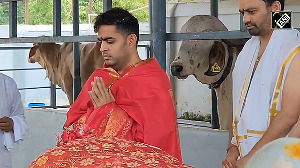The thrust will be on improving connectivity in economic corridors and remote and border areas with a view to hike trade and enable faster movement of cargo.

Any report card on four years of the BJP-led NDA government at the Centre will show that its performance in the roads and highways sector has been outstanding.
Since 2013-14, there has been a 77 per cent rise in awarding highway contracts and a 38 per cent increase in the construction of roads and highways.
To ramp up the momentum and extent of road building even further, last October the government launched the ambitious Bharatmala Pariyojana, which aims to construct a network of highways connecting the western and eastern parts of the country at an estimated cost of Rs 7 trillion.
The thrust will be on improving connectivity in economic corridors and remote and border areas with a view to hike trade and enable faster movement of cargo.
Bharatmala is, in fact, the largest highways project in the country after the National Highway Development Programme (NHDP) which oversaw the building of 50,000 km of roads.
The government is clearly gung-ho about this big-ticket infrastructure project.
Road transport and highways minister Nitin Gadkari has remarked that once completed, the Centre’s two flagship schemes - Bharatmala and Sagarmala (a string of ports on the Indian Ocean) - would be like a ‘varmala’ (garland) around the country.
Experts too feel that Bharatmala is going to be the highway sector’s next big story. “It (Bharatmala) is like a banyan tree with everything under it,” says Abhaya Agarwal, partner and PPP leader, EY India.
The work to get the project off the ground has begun already and both the Union government and the National Highways Authority of India seem all set to kickstart it.
“A lot of DPRs (Detailed Project Reports) have been prepared for the green-field projects under the scheme. Some contracts have also started rolling out,” says an official in the road ministry.
However, there is no confirmation as yet on whether the first phase of the project would be complete within its stated deadline of 2021-22.
Phase One of Bharatmala Pariyojana aims to build 24,800 km of roads in addition to 10,000 km of NHDP roads, which takes the total to a massive 34,800 kms of roadworks.
Slated to cost Rs 550 crore, the first phase would be funded through various channels, including Rs 2.09 trillion from the market, Rs 1.06 trillion from private investment and Rs 2.19 trillion from the central road fund or toll collection.
The average cost of constructing 1 km of road is Rs 130 million.
Under the scheme 50 national corridors will be transformed into major arteries.
The government claims that once the roads are up and running, 70 - 80 per cent of freight will move along the national carriageways as against the 40 per cent at present.
What’s more, the new roads will enable 550 districts to get access to the national highways as against 300 districts that are similarly connected at present.
Bharatmala also promises to be a huge engine of employment. It expects to generate direct and indirect employment - nearly 100 million man days of jobs during the period of road construction and an additional 22 million jobs from the rise in economic activity due to better connectivity across the country.
However, the flipside of Bharatmala is that it could put certain completed toll roads in jeopardy.
According to rating agency ICRA, the scheme might affect 25 toll road projects with a total debt of Rs 19,435 crore.
“The Bharatmala network, designed on the shortest possible route connecting the origin and destination, though well-thought-through and a step in the right direction, is bound to impact the existing network by directly competing with a few stretches, including some of the existing build-operate-transfer (BOT) (Toll) road projects,” the rating agency said in a statement earlier this year.
First mooted in April 2015, the Bharatmala project will commence in Gujarat and Rajasthan, then move to Punjab and subsequently embrace the Himalayan belt through Jammu and Kashmir, Himachal Pradesh, Uttarakhand, parts of Uttar Pradesh, Bihar, West Bengal, Sikkim, Assam, right up to the Indo-Myanmar border in Arunachal Pradesh and Manipur and on to Mizoram.
The aim is to provide uniform, four-lane highways in key corridors to permit faster movement of cargo vehicles.
The government plans to seek the help of the Border Roads Organisation when constructing roads in difficult and remote terrain.
Clearly, Bharatmala has the potential to emerge as another feather in the cap for the Modi government.
Photograph: Fayaz Kabli/Reuters












 © 2025
© 2025